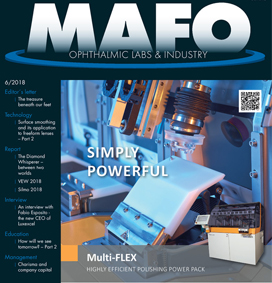DECEMBER 2016
RXPERTISE
Eyeing the Future of Spectacle Lens Design
The advent of free-form manufacturing technology in the early 2000s brought a burst of energy to spectacle lens design. This powerful new tool enabled lens designers to create a myriad of new multifocal and single vision products that expanded the boundaries of vision and changed the way we see.
But what’s next for free-form technology? Will spectacle lens designers keep refining existing designs? Are we reaching an endpoint, or is there a big leap forward coming soon?
20/20 posed these questions to some of the top executives in the spectacle lens field. you’ll find their thought provoking responses and insights on the following pages.
We also asked these lens experts to share their thoughts about bifocals and trifocals, the vision needs of the growing senior population, the myopia boom and how they see the smartglass market taking shape.
—Andrew Karp
What’s next for free-form technology? Will spectacle lens designers keep refining existing designs? Are we reaching an endpoint, or is there a big leap forward coming soon?
“At this time, spectacle lens designers have achieved a much higher level of lens design sophistication than the rest of our industry is ready to utilize to the full benefit of the patient. In our opinion, the main stumbling block is the lack of functional measuring or verification instruments in order for the ECP to be able to verify that the prescription has been filed in compliance with the patient prescription requirements from the patient vision point of view.
“For conventional and non-compensated free-form lenses, the ECP knows how to inspect and verify the lenses for compliance with the patient Rx. When the lenses are individually optimized designs, the standard lens inspection process is no longer viable. The lab provides the ECP with values to be measured at DRP, PRP and NRP, but those values are calculated substitute values for the sole purpose of lensmeter verification.
“The problem the ECP is faced with is that there are no functional and effective inspection tools to evaluate the given parameters of the individually optimized lens from the patient’s vision point of view. In effect, we are asking the ECP to blindly accept and trust that there is zero chance of error in the lens design, complex lens calculations, data input, equipment calibration or malfunction during the entire lens production process. To ask that of the ECP who has built a successful practice based on accepting total responsibility for the quality of the prescription eyeglasses dispensed to the patient does not appear to be quite reasonable. Therefore, before the lens designers venture into even more sophisticated lens designs, we have to wait for someone in the inspection instrument field to come up with such a tool.”

